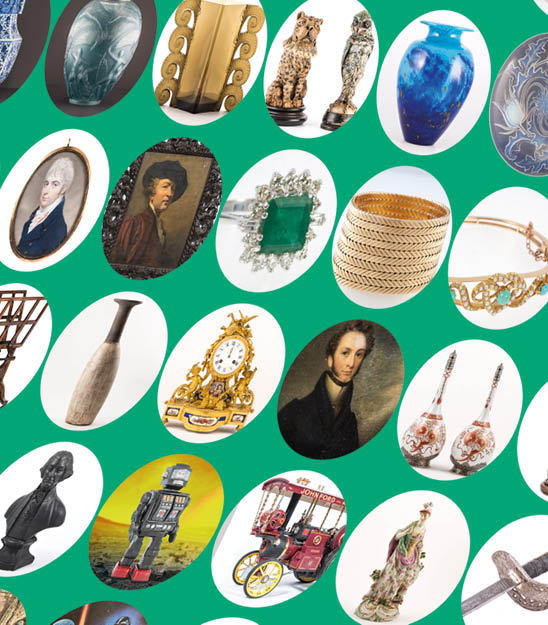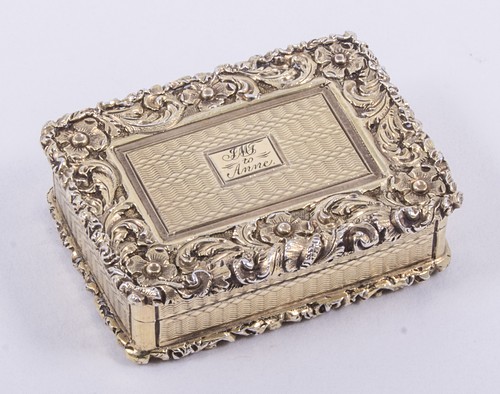1400x500.jpg)
1400x500.jpg)
For centuries, silver has been a material of choice for manufacturing highly decorative objects, and a means by many to display their wealth to guests in their home. In Britain, hallmarking of silver items has been in practice for over 700 years, and it brings with it a professional standard of silver quality - reassuring the buyer of their investment that the metal is "up to standard". It is these hallmarks that reveal an item's maker, date, and Assay Office. As with any area of collecting, certain makers can command a premium, and there are various areas of collecting silver objects that can generate some surprising results at auction. With the advancement of materials and technologies in the 18th and 19th centuries, the manufacturing of silver plated materials was introduced. Items of silver plate have always been more affordable, but early examples of Sheffield Plate, or by principal makers or designers can command good interest at auction.
At Gildings our comprehensive auction calendar covers all budgets when buying or selling silver at auction. We host fortnightly Antiques & Collectors auctions featuring silver from all periods, with higher value and fine examples offered as part of our Fine Art & Antiques auctions. All auctions can be viewed at our saleroom in Market Harborough, Leicestershire, with easy transport links via road and rail.
If buyers are unable to attend the auction, they can bid online, via the telephone, or leave an absentee bid.
If you would like to be kept informed of silver valuations and silver auctions sign-up to our dedicated newsletter. We’ll alert you to upcoming events, consignment closing dates, and other silver-related news. Or if you’re looking for something specific, create an account and set up a Lot Alert - we’ll send you a notification of anything meeting your criteria coming up for auction with us.
If you have an item or items of silver or silver plate that you would like valued for auction it couldn’t be easier. A realistic auction estimate can only really be discussed having seen and handled the piece(s). You can first submit an enquiry via our Valuations Form where you can upload images and details of your items. From these images our Specialist will be in contact to discuss further and to make an appointment to see them in person. For larger collections/ quantities a home visit may be arranged.
As with any valuation, certain factors will be crucial in determining a more accurate and realistic auction estimate. Not until our Specialist has seen an item in person would the final auction advice be agreed.
Gildings can also provide professional valuations of Silver and Silver Plate, for insurance or probate purposes. As a professional valuation there would be a charge for this service. Please contact us to discuss further.


This term covers a large range of items including tea and coffee sets, tureens and serving vessels, sweet meat dishes, tankards, and the like. Given the breadth of items under this category it goes without saying there are various areas of interest within it. As with any areas of buying silver certain makers are more regarded than others and will bring with them an extra bid or two. Paul Storr is one such name who is considered one of the finest silversmiths of the early 19th century. His works were presented to the grandest houses and Royalty of the day. Some collectors focus on the region a piece was made or assayed in. At points throughout the last 700 years some provincial towns had their own assay offices, and so some look for pieces of silver from Newcastle or Exeter, or the Irish and Scottish regions. The Langlands are one such notable silversmithing family from Newcastle, renowned for their tankards, mugs, and flatware.
Flat-ware covers cutlery which has obviously adorned our tables for centuries. As trends and fashions have come and gone, different patterns have arisen. The patterns can be very plain, such as Hanoverian, Old English, and Fiddle pattern, to very ornate and decorative such as the King’s pattern. Designers have made subtle changes and variations to the more traditional patterns to form new designs. Silver canteens commonly have steel-bladed knives as a purely silver blade would prove too soft to be effective at cutting. Fish knives however do tend to have silver blades given the delicacy of the fish you would cut with it. Certain items, such as cheese and marrow scoops, can be collected in their own right. And harking back to our love of tea, the caddy spoon is also a large area of collecting.

There are a good many collectors for small items of virtue, such as card cases, snuff boxes, vinaigrettes, nutmeg or spice graters, or pin cushions. A lot of the more highly desirable pieces tend to be made of silver or silver-gilt. Within each collecting field maker is as important as ever. Nathaniel Mills is a well-regarded Victorian maker of boxes. Some of their pieces would be elaborated cast, chased, or engine turned, while other examples might be embossed with significant landmarks. Other boxes and cases which always generate good interest are those that incorporate enamelled panels. Nutmeg graters from the Georgian period are always very popular. And humble novelty cast pieces such as pin cushions can come in all shapes and sizes – from farm yard animals, to birds, to decorative shoes.

In the 15th to 18th century very little cutlery would have been used at all, often just the single spoon being all you had to eat with. If your status and wealth was sufficiently high enough, your spoon would likely have been made of silver. For early spoon collectors there is heavy interest in the terminal of the spoon (the tip of the handle), and the maker. Terminal name designs include Apostle spoons that would have been cast in sets of twelve and depict individual saints. Slip-top, seal-top, trefid, and dog-nose terminals are also chartered through the middle-ages. One of the top makers of early spoons is William Cawdell, who was based in London and worked during the late 16th- and early 17th century. The shape of the bowl is also important as the years of use would probably have seen the shape eroded, or it may have been repaired.
It goes without saying that silver from other countries and cultures also commands a good deal of interest at auction. All countries in Western Europe have their own assaying standards and markings, and with it centuries of history and practices. Certain areas have strong historical links with silver-smithing, such as the island of Malta. Then there are the power houses of Russia and Scandinavia; in Asia silver-smiths in mainland China, Honk Kong, and Japan have produced some exquisite works; and in the Americas you have the 19th century producers such as Gorham and the Tiffany Studios. Many pieces have travelled to these shores over the years, and we enjoy facilitating the next onward step of their journey.
The design-led decorative art movements of the 20th century have all embraced the use of silver to startling effect. The Austrian designers associated with the Wiener Werkstätte such as Josef Hoffmann produced striking vessels in silver. The British Arts and Crafts movement similarly utilised it's characteristics often in combination with enamels, such as those of Liberty & Co. Then the Art Deco movements that swept the world produced some very stylish designs of everyday objects such as the teaset or the humble toast rack, and turned it into a piece of high decadence. The Scandinavian movement has been headed by Georg Jensen since the 1920s. The post-1945 silversmiths employ designs of great modernity, and you see studios becoming much more ambitious with the techniques they apply, introducing textures and colourings – such as Gerald Benney’s designs. The 21st century designers and artists using silver are really pushing boundaries in making much more sculpture abstract pieces. Silver of this nature is most likely to be offered in our 20th century Decorative Arts auctions.